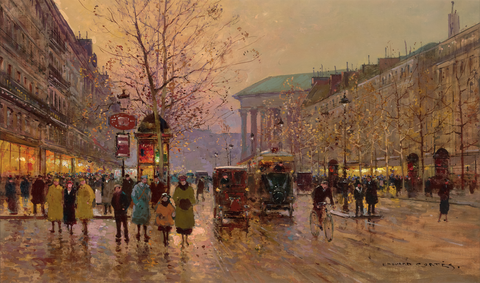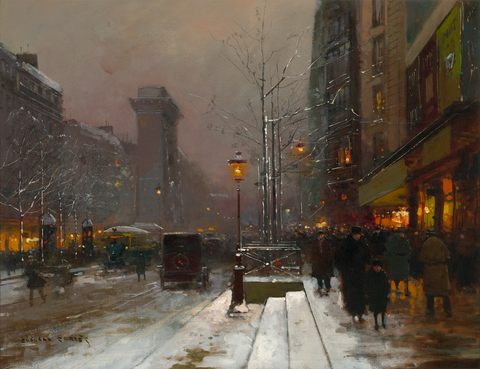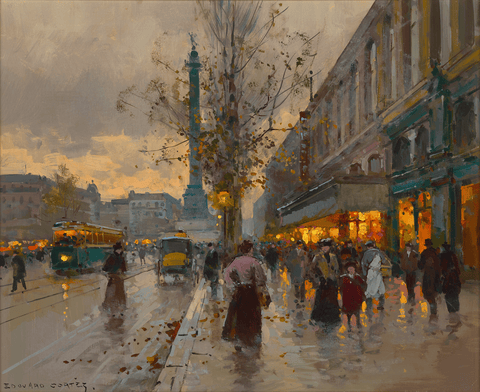Artists & Artisans
Cortès, Edouard Léon
Edouard Léon Cortès represents the culmination of an artistic legacy: his father and grandfather before him were both accomplished painters. Both predecessors worked and lived in Seville, Spain, with Edouard's father Antonio Cortès achieving prominence as a Royal Court painter. In his 30's however, Antonio traveled to Paris to attend the Exposition Universelle. He fell in love with the city, which he often depicted in his art, and ultimately relocated there permanently.
EARLY LIFE
It was just outside of Paris, in the village of Lagny-sur-Marne, where Cortès was born in August of 1882. As a young boy, he received a traditional elementary education. Upon earning his certificate at the age of thirteen, Cortès apprenticed within his father's studio to learn the familial craft of painting. He proved to be a quick study and demonstrated remarkable talent from an early age.
His burgeoning talent was rewarded shortly thereafter with a debut at the famed Parisian Salon in April of 1899. His painting Le Labour was positively reviewed in French newspapers Le Figaro and Le Matin and even received international press in Germany and England. This attention at sixteen years of age proved to be an auspicious sign for the artist's career.
BURGEONING CAREER
Along with most of the artist's early work, Le Labour depicted a farm scene, following in the Realist footsteps of his father. However, around the turn of the century, the artist began to explore the city of Paris and capture the elegant subtleties of its light and people on his canvas. Although the painter continued to dabble in rural landscapes, it was for the impressionistic cityscapes and street scenes of Paris for which Cortès would ultimately become celebrated.
In 1914, shortly after marrying Fernande Joyeuse, Cortès enlisted in the Army to join France's fight against the Central Powers during World War I. After being wounded on the front lines and receiving a Croix de Guerre, he undertook a staff role in which his talents as a draftsman were utilized to render enemy positions and record wartime scenes. His involvement in the Army contradicted the artist's strong pacifist leanings. He became more devout in his pacifism after World War I, to such an extent that he later refused to accept the Légion d'Honneur that the French government offered to him.
After the war, the artist resettled in Lagny, whose bustling artist community Cortès involved himself with by becoming the first president of their Union des Beaux-Arts. He exhibited alongside the local artists, while simultaneously showing his work at the most significant of the Parisian Salons.
THE PARISIAN POET OF PAINTING
Édouard Léon Cortès developed his craft within an artistic milieu that included figures such as Antoine Blanchard, known for capturing the charm of Parisian street scenes, and Jean Béraud, celebrated for his depictions of Parisian nightlife. Cortès shared a vision with these contemporaries and with Eugène Galien-Laloue, whose diverse Paris cityscapes and impressionist paintings also evoked the vibrant streets, galleries, and horse-drawn carriages of the era.
By this point in time, there was international demand for Cortès' paintings. Nonetheless, the artist maintained a humble existence, avoiding the limelight and rarely documenting his work. Fortunately, art historian Nicole Verdier would later compile a catalogue raisonné of Cortès' works, aiding in the authentication of the work by the famous but often-copied French painter and further solidifying his place among the great chroniclers of French life in contemporary art.
Cortès continued his painterly romance with Paris for the duration of his career. Even after the days of formal streetwear and horse-drawn carriages had vanished, the painter continued to include them in his work. When questioned about this artistic choice, the artist explained that he yearned to exist in the days prior to World War II and all of its tragedies. Cortès painted until his death in 1969. In spite of his desire to avoid recognition during his lifetime, the town of Lagny elected to name a street in the artist's honor after his death.
Cortès’ influence endures in contemporary art through numerous auction houses and galleries, where his paintings continue to capture attention. For those looking to own a part of this legacy, M.S. Rau offers collectors a chance to bring home original work from the French Post-Impressionist artist. Explore our selection of original Eduoard Cortes paintings for sale.
Artists & Artisans
Cortès, Edouard Léon
Edouard Léon Cortès represents the culmination of an artistic legacy: his father and grandfather before him were both accomplished painters. Both predecessors worked and lived in Seville, Spain, with Edouard's father Antonio Cortès achieving prominence as a Royal Court painter. In his 30's however, Antonio traveled to Paris to attend the Exposition Universelle. He fell in love with the city, which he often depicted in his art, and ultimately relocated there permanently.
EARLY LIFE
It was just outside of Paris, in the village of Lagny-sur-Marne, where Cortès was born in August of 1882. As a young boy, he received a traditional elementary education. Upon earning his certificate at the age of thirteen, Cortès apprenticed within his father's studio to learn the familial craft of painting. He proved to be a quick study and demonstrated remarkable talent from an early age.
His burgeoning talent was rewarded shortly thereafter with a debut at the famed Parisian Salon in April of 1899. His painting Le Labour was positively reviewed in French newspapers Le Figaro and Le Matin and even received international press in Germany and England. This attention at sixteen years of age proved to be an auspicious sign for the artist's career.
BURGEONING CAREER
Along with most of the artist's early work, Le Labour depicted a farm scene, following in the Realist footsteps of his father. However, around the turn of the century, the artist began to explore the city of Paris and capture the elegant subtleties of its light and people on his canvas. Although the painter continued to dabble in rural landscapes, it was for the impressionistic cityscapes and street scenes of Paris for which Cortès would ultimately become celebrated.
In 1914, shortly after marrying Fernande Joyeuse, Cortès enlisted in the Army to join France's fight against the Central Powers during World War I. After being wounded on the front lines and receiving a Croix de Guerre, he undertook a staff role in which his talents as a draftsman were utilized to render enemy positions and record wartime scenes. His involvement in the Army contradicted the artist's strong pacifist leanings. He became more devout in his pacifism after World War I, to such an extent that he later refused to accept the Légion d'Honneur that the French government offered to him.
After the war, the artist resettled in Lagny, whose bustling artist community Cortès involved himself with by becoming the first president of their Union des Beaux-Arts. He exhibited alongside the local artists, while simultaneously showing his work at the most significant of the Parisian Salons.
THE PARISIAN POET OF PAINTING
Édouard Léon Cortès developed his craft within an artistic milieu that included figures such as Antoine Blanchard, known for capturing the charm of Parisian street scenes, and Jean Béraud, celebrated for his depictions of Parisian nightlife. Cortès shared a vision with these contemporaries and with Eugène Galien-Laloue, whose diverse Paris cityscapes and impressionist paintings also evoked the vibrant streets, galleries, and horse-drawn carriages of the era.
By this point in time, there was international demand for Cortès' paintings. Nonetheless, the artist maintained a humble existence, avoiding the limelight and rarely documenting his work. Fortunately, art historian Nicole Verdier would later compile a catalogue raisonné of Cortès' works, aiding in the authentication of the work by the famous but often-copied French painter and further solidifying his place among the great chroniclers of French life in contemporary art.
Cortès continued his painterly romance with Paris for the duration of his career. Even after the days of formal streetwear and horse-drawn carriages had vanished, the painter continued to include them in his work. When questioned about this artistic choice, the artist explained that he yearned to exist in the days prior to World War II and all of its tragedies. Cortès painted until his death in 1969. In spite of his desire to avoid recognition during his lifetime, the town of Lagny elected to name a street in the artist's honor after his death.
Cortès’ influence endures in contemporary art through numerous auction houses and galleries, where his paintings continue to capture attention. For those looking to own a part of this legacy, M.S. Rau offers collectors a chance to bring home original work from the French Post-Impressionist artist. Explore our selection of original Eduoard Cortes paintings for sale.






